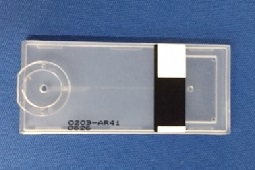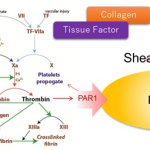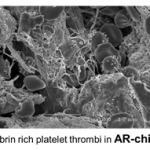
HD Chip for T-TAS® 01
$0.00
A complex web of biochemical and physical reactions of between platelets and coagulation factors at the site of vascular injury are required to achieve hemostasis. Under flow conditions, platelet activation and the coagulation processes are dynamically intertwined with one another affected by platelets, coagulation factors, and their various inhibitors and activators.
However, the analytical conditions used by conventional hemostatic tests are not suitable for the analysis of blood with a low platelet count (fewer than 100k/µL, also known as thrombocytopenia). In addition to genetic causes, thrombocytopenia is frequently observed in surgery as well as in response to various cancer treatments.
The HD chip has a 50 µm thick flow chamber coated with both collagen and thromboplastin (tissue factor) to activate both primary (platelet clot) and secondary (fibrin clot) hemostasis. Blood flow is maintained at 1200/s mimicking in vivo blood flow through arteries. These conditions allow the HD Chip for T-TAS 01 to be effective in blood samples with platelet concentrations as low as 10k/µL.
Anticoagulated whole blood is perfused at physiologic temperatures at a constant rate through the flow chamber coated with tissue factor and collagen. As coagulation and platelet activation progresses and begins forming a thrombus, the pressure required to move the blood at the given shear rate increases. These pressure changes are monitored by a pressure sensor upstream of the chamber.
A distinct advantage of using a flow chamber system for the measurement of thrombus formation is the correlation with the in vivo thrombus formation process. Scanning electron micrographs (SEM) of thrombi inside the AR chip show that thrombi formed within the microchip capillary under flow conditions were tightly packed and contained numerous activated platelets. In contrast, thrombi formed under static conditions were mainly composed of erythrocytes and fibrin fibers.
The HD Chip comes pre-packaged in individual, sealed foil pouches. Unopened, they are stable for ~18 months from date of manufacture when stored at 2-8oC. Once removed from the pouch, the HD chip should be used as soon as possible.
Test Results
In the HD Chip, platelets will adhere and aggregate on the surface of the tissue-factor and collagen coated capillary as the blood is moved through the analytical path of the T-TAS® 01 at a constant flow rate. The aggregate gradually increases in size as the activated platelets bind additional platelets and fibrin strands in the region occluding the path. This will result in an increase in flow pressure needed to maintain a steady flow-rate, which is measured by the T-TAS 01. The changes in the flow pressure pattern reflect the formation processes of the platelet plug.
Unlike the AR Chip, the HD Chip is specifically designed to be used with hemodiluted blood; such as seen following surgery, plasma transfusions during trauma, or in cases of thrombocytopenia (platelet count from 10,000-100,000/µL).
The Occlusion Start Time (OST) is the lag time for the flow pressure to reach 10 kPa due to partial occlusion of the capillary.
The Occlusion Time (OT) is the time needed to increase pressure to 60 kPa above baseline owing to near or complete occlusion of the capillary.
The Area Under the Curve (AUC) is the number derived from the area under the flow-vs-time and is related to the overall thrombus formation. A low value could indicate low thrombus formation potential of the sample.



